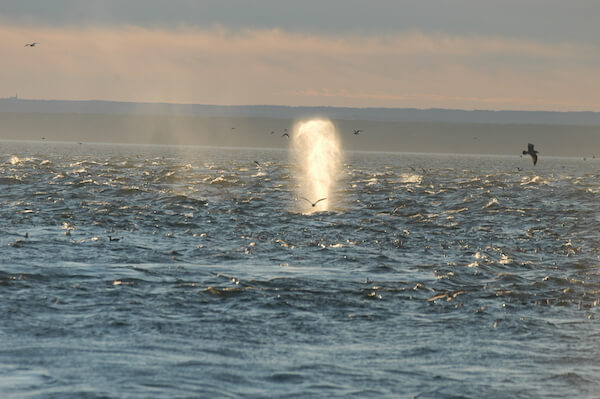Whales reveal just a tiny fraction of their bodies before quickly disappearing again, leaving observers puzzled as to who they are. Fortunately, there are a few clues to guide us.
For those observing minke whales, it is not always easy to distinguish these animals from their “big cousins”, the fin whales. Both species have black skin and a streamlined body. However, fin whales are almost twice the size of minke whales and up to four times their weight. The spout of the minke whale is not easy to see, while that of the fin whale, which can reach 4 to 6 m high, can be heard from afar. At the surface, the blowholes of the fin whale appears well before its dorsal fin, while in the minke whale, everything appears simultaneously.
Taking into account these field marks, it becomes clearer that the individual seen off Pointe-des-Monts on August 15 was a fin whale, while the one spotted off Port-au-Persil on August 14 was a minke whale. In fact, minke whales are numerous in several regions of the St. Lawrence River: at the mouth of the Saguenay River, along the steep banks of the Charlevoix and Côte-Nord regions, and in Gaspé Bay.
Four fin whales are observed in the Estuary. One day, two fin whales are accompanied by a blue whale opposite Les Escoumins. The massive blue whale is Chameau (in French), probably one of the most famous of her species in the Estuary. Known since 1991, this female is a regular in the Estuary. She is easily recognized by the deep depression in her back.
How can one tell a blue whale from a fin whale? These are the two largest animals on Earth, with the blue whale weighing almost twice as much as its close relative. Audible up to several kilometres away and occasionally exceeding 6 m in height, its spout emerges from a pair of blowholes of remarkable size (article in French): between 40 and 50 cm. The blue whale’s “coat” is pale blue-gray and speckled.
Off Cap Gaspé, at least three blue whales are noted. On the other side of the river, a blue whale and two fin whales are photographed southeast of Ouellet Bank in the Sept-Îles region. The humpbacks Capone and Bad Chemistry – the latter with her newborn – are identified. Jacques Gélineau, head of marine mammal surveys for the Bay of Sept-Îles characterization project being carried out by the Nordic Institute for Environmental and Occupational Health Research (INREST), was the one who spotted these animals during his most recent transect. He also emphasizes the unexpected visit of three humpbacks and one fin whale in the Bay of Sept-Îles, accompanied by the usual minke whales.
In Franquelin, a collaborator spots two humpback whales early in the morning of August 14. One of them seems smaller. Is it a mother and her calf? The same observation was made by a collaborator from Pointe-des-Monts who observed two humpbacks the following day, one of which seemed to be smaller in size.
The humpbacks Tingley and Tic Tac Toe are in the Mingan area this week, both accompanied by their respective calves. They are among the fifteen or so individuals seen by the staff of the Mingan Island Cetacean Study (MICS). Researcher Christian Ramp points out that there are nearly as many fin whales in the area. And, the female humpback Aramis, Tic Tac Toe’s first baby (born in 2007), is seen very briefly in the Estuary.
Thar she blows!
“Unquestionably, it’s the shape of the spout that tipped me off,” explains the Pointe-des-Monts resident who saw the two humpbacks on August 15. The spouts of these whales are oval in shape and about 3 m high. When they dive, this species lifts its tail, revealing the black-and-white pattern underneath. These rather plump whales sometimes perform complete breaches out of the water. One observer from Godbout was lucky enough to witness such behaviour on August 12 as she watched two humpbacks from shore.
“Unquestionably, it’s the shape of the spout that tipped me off,” explains the Pointe-des-Monts resident who saw the two humpbacks on August 15. The spouts of these whales are oval in shape and about 3 m high. When they dive, this species lifts its tail, revealing the black-and-white pattern underneath. These rather plump whales sometimes perform complete breaches out of the water. One observer from Godbout was lucky enough to witness such behaviour on August 12 as she watched two humpbacks from shore.
A “V-shaped” spout? This typical spout is explained by the right whale’s two widely-spaced nostrils. The absence of the dorsal fin is also a good way to recognize it. These characteristics allowed a captain of the Forestville-Rimouski ferry to identify one of them off the coast of Forestville on August 13.
Despite all these “tricks”, differentiating whales is far from being straightforward. Weather conditions must be favourable. The behaviour of the animals also plays an important role in identifying their species. A pair of binoculars are therefore a valuable tool for recognizing whales. And yet there are still the occasional surprises, such as the bluefin tuna and white-sided dolphins seen at the entrance to Gaspé Bay in the past few days.





